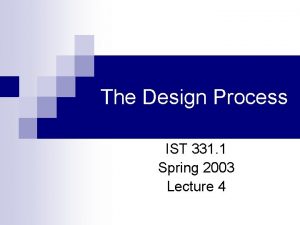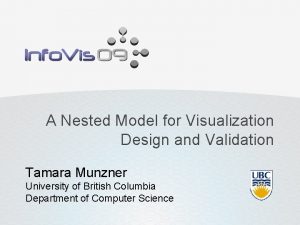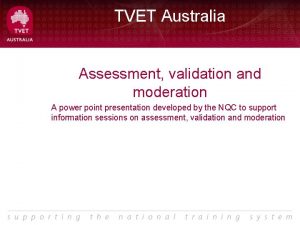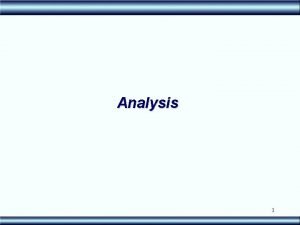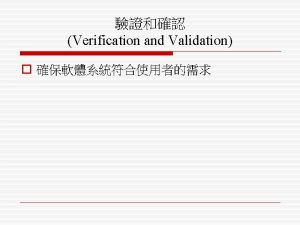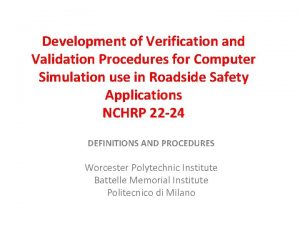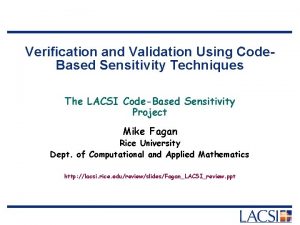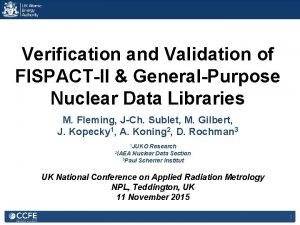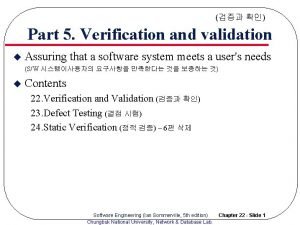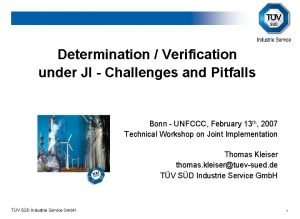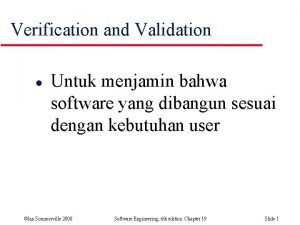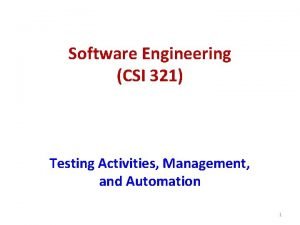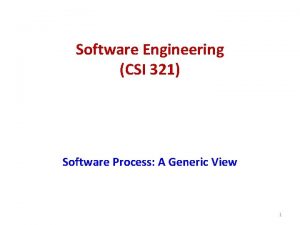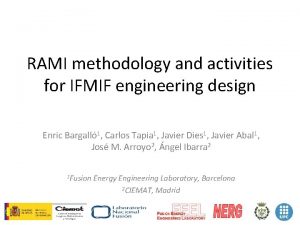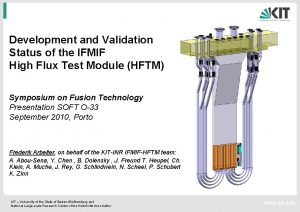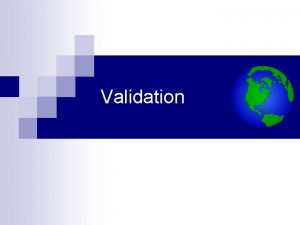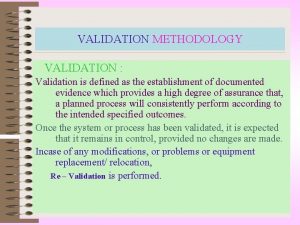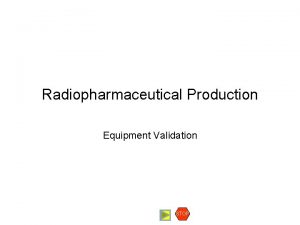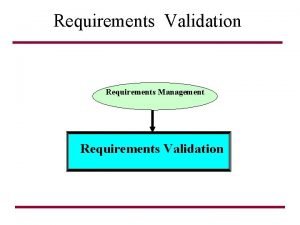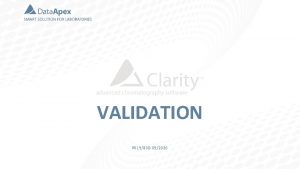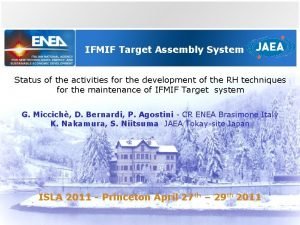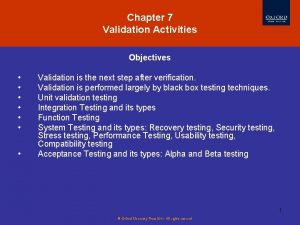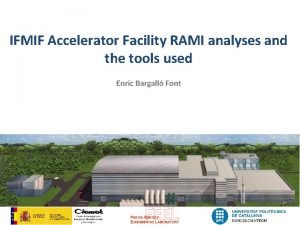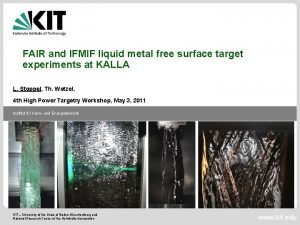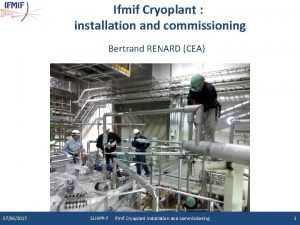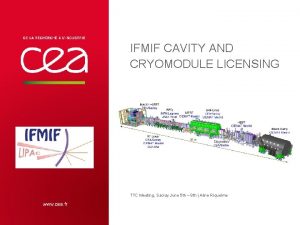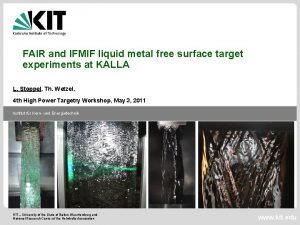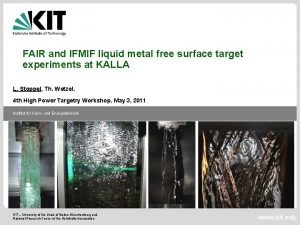IFMIF Engineering Validation and Engineering Design Activities IFMIF


























- Slides: 26

IFMIF Engineering Validation and Engineering Design Activities IFMIF Specifications from the Users point of view P. Garina, E. Diegeleb, R. Heidingerc, A. Ibarrad, S. Jitsukawae, H. Kimurae , A. Möslangg, T. Murogah, T. Nishitanii, Y. Poitevinb, M. Sugimotoi, M. Zmitkob CEA, IFMIF/EVEDA Project Team, Rokkasho, Japan b F 4 E, Barcelona, Spain c F 4 E, Garching, Germany d CIEMAT, Avda. Complutense 22, Madrid 28040 Spain e JAEA, Tokai, Japan f JAEA, Rokkasho, Japan g KIT, Karlsruhe, Germany h NIFS, Toki, Japan i JAEA, IFMIF/EVEDA Project Team, Rokkasho, Japan a

IFMIF Engineering Validation and Engineering Design Activities Outline • What is IFMIF? • The Specifications Working Group • Main Findings – The IFMIF mission – Structural materials – Blanket Functional materials – Non-metallic materials • Conclusions

IFMIF Engineering Validation and Engineering Design Activities What is IFMIF and why is it needed? IFMIF (International Fusion Materials Irradiation Facility) is a neutron source aimed to generate a fusion reactor relevant radiation environment. It is fusion specific and unique with respect to • neutron- spectrum (damage and transmutation) most similar to fusion in-vessel component, • high flux (allowing for moderately accelerated testing), • sufficiently large test volume, • flexibility in loading conditions and instrumentation. Currently the EVEDA (Engineering Validation & Engineering Design Activity) phase is performed as part of the Japanese-European “Broader Approach”

IFMIF Engineering Validation and Engineering Design Activities Principle of IFMIF Accelerator Lithium Target 25± 1 mm thick, 15 m/s (125 m. A x 2) Source 140 m. A LEBT MEBT RFQ Half Wave Resonator Superconducting Linac D+ 100 ke. V 5 Me. V 9 n-flux density (s-1 cm-2 Me. V 1) RF Power System 1 E+17 14. 5 26 Test Cell HEBT H M 40 Me. V Beam shape: 200 x 50 mm 2 High (>20 dpa/y, 0. 5 L) Medium (>1 dpa/y, 6 L) Low (<1 dpa/y, > 8 L) DEMO 1 E+16 IFMIF Medium Flux Module IFMIF High Flux Module 1 E+15 Typical reactions 7 Li(d, 2 n)7 Be 6 Li(d, n)7 Be 6 Li(n, T)4 He 1 E+14 1 E+13 1 E+12 1 E+11 1 E-03 1 E-02 1 E-01 1 E+00 1 E+01 Neutron Energy (Me. V) 1 E+02 L

IFMIF Engineering Validation and Engineering Design Activities The Specifications Working Group • IFMIF design specifications should be based on the users needs. In order to better know the Users requirements, a Specifications Working Group was established in 2009 with the following Objectives: – Define high level requirements in terms of irradiation and post irradiation programs and schedule. – Identify reference scenario(s) for the irradiation cycle. – Define a modular set of examinations to be carried out in IFMIF plant after irradiation • The Specifications Working Group delivered a document, called “IFMIF Plant Specifications”, that shall be the top document of the IFMIF Engineering Design Report.

IFMIF Engineering Validation and Engineering Design Activities Outline • What is IFMIF? • The Specifications Working Group • Main Findings – The IFMIF mission – Structural materials – Blanket Functional materials – Non-metallic materials • Conclusions

IFMIF Engineering Validation and Engineering Design Activities Main Relations between ITER, IFMIF and DEMO • The main elements in the overall roadmap toward fusion reactors are ITER, IFMIF and DEMO. • The general definition of DEMO missions are demonstration of plant-scale power generation (eg. reliable operation and continuous delivery of electricity to the grid) and feasibility of economical competitiveness with conventional energy sources. • DEMO engineering design will be carried out based on the information supplied from ITER and IFMIF. • First input required up to 30 -50 dpa for the DEMO Engineering Design including those for licensing and safety assessment • Second input required up to 70 -100 for DEMO lifetime evaluation • Data up to 150 dpa will be required for application to commercial power plants • IFMIF is on the critical path for the realization of a next step machine aiming to proof fusion technology. Data generated from IFMIF are at least needed and expected within the same time frame as results from ITER operation.

IFMIF Engineering Validation and Engineering Design Activities Road map, exemplified for breeder blankets Primary Option Advanced Options Limited Efforts DEMO Advanced stage, Commercial Design Const. Operation Advanced Blanket Tests Licensing Test Blanket Modules ITER Development of of Blanket and Materials Development Primary option (1 st generation): RAF/M, Water of He cooled Blanket RAF/M, Water or He cooled Blanket Advanced materials (V Alloys, Si. C/Si. C) Advanced High Materials (V Temperature Alloys, Si. C/Si. C)Blankets for (Liquid Li. Pb, Flibe, High Tblankets Gas) (advanced) high. Li, temperature IFMIF EVEDA, Construction Design Data Lifetime Evaluation Irradiation Tests, Blanket Functional Tests, Licensing data

IFMIF Engineering Validation and Engineering Design Activities The role of IFMIF in fusion road maps Independent of specific ideas and roadmap developed in Japan and the EU, there are some essential commonalities, i. e. ITER, DEMO and the … Role of IFMIF. Expected contributions will include, but are not limited to • Qualification of candidate materials, in terms of generation of engineering data and definition of performance limits, up to about full lifetime of anticipated use in a fusion DEMO reactor – In particular, in the initial period of operation: To supply key data necessary for engineering design of DEMO • Completion, calibration and validation of data bases (mainly generated from fission reactors and particle accelerators) • Advanced material development (towards power plant application) – To promote, verify or confirm selection processes. • Validation of fundamental understanding of radiation response of materials – Science-related modeling of irradiation effects should be validated and benchmarked at length-scale and time-scale relevant for engineering application. – Experiments performed in IFMIF could validate assumptions or adjust parameters.

IFMIF Engineering Validation and Engineering Design Activities The IFMIF mission & and a likely (staged) scenario First period of IFMIF (corresponding to the role of IFMIF): • Definition of performance limits – BB structural materials, demonstration to 30~50 dpa; divertor up to ~1020 dpa. • Validation of data required for licensing and safety assessment. • Blanket/functional materials tests prior to or complementary to ITERTBM (depends on timely availability) • Benchmarking of irradiation modeling (1 st stage) Following period, • Full lifetime evaluation of structural materials. • Selection or optimization of materials • Increasing efforts to characterize structural materials for advanced blanket concepts. • Validation of fundamental understanding of radiation response – Benchmarking at fusion relevant length-scale and time-scale

IFMIF Engineering Validation and Engineering Design Activities Outline • What is IFMIF? • The Specifications Working Group • Main Findings – The IFMIF mission – Structural materials – Blanket Functional materials – Non-metallic materials • Conclusions

IFMIF Engineering Validation and Engineering Design Activities Structural materials– (Which & When) First phase: To evaluate structural materials for DEMO engineering and to validate for licensing of a first Breeder Blanket. Common (to all 1 st generation BB): ferritic martensitic steels (RAFM), Second phase (Blankets) : RAFM steels for full DEMO life. Then: Materials for BB at improved thermal efficiency (V, Si. C/Si. C) “advanced". Divertor: Qualify and validate materials for DEMO-Divertor (concepts less mature than BB; final material specification and selection likely later) Service condition breeder blanket RA Ferritic/Martensitic Steel (DEMO target) Temperature 300 -550 °C /Max. temperature for ODS < 650/750 °C) Neutron fluence First DEMO BB 3 -5 MWa/m 2 dpa / Final goal 10 MWa/m 2 Damage levels 30 - 100 dpa (with 10 appm He/dpa and 40 appm H/dpa Service condition of the materials for advanced concept blankets and divertors Material Vanadium alloys Si. C/Si. C composites Tungsten alloys Maximum Temperature < 800 °C < 1, 100 °C 650 -1, 200 °C Coolant He gas / liquid metal He gas Liquid Metal

IFMIF Engineering Validation and Engineering Design Activities Structural materials– (What & How) Degradation of properties dependend from T(emperature), n-energy spectrum (He ) and damage rates (exposure time). Critical properties to be tested for base material and joints include: • Reduction in fracture toughness and the shift of DBTT (ductile-brittle transition) [low T] • He embrittlement [at high T] • (Irradiation) creep and swelling [medium T] General requirements: Determine tensile (strength and ductility), fracture, creep, fatigue in the full T range to generate engineering allowable data. Development for SSTT (small scale test technique) mandatory. Demonstration of methodology and implementation in international norms and standards. Special requirements (T-stability and homogeneity): • Temperature should not deviate more than (+/-) 3% [this values has to be confirmed]. Rational: Some changes in properties (particularly at ~ DBTT) show a steep gradient.

IFMIF Engineering Validation and Engineering Design Activities Outline • What is IFMIF? • The Specifications Working Group • Main Findings – The IFMIF mission – Structural materials – Blanket Functional materials – Non-metallic materials • Conclusions

IFMIF Engineering Validation and Engineering Design Activities Blanket Functional materials • The breeding blankets are key components of a DEMO reactor. Several concepts have been proposed: • Solid: HCPB & WCPB • Liquid: HCLL, (DCLL) – Eo. L limited by structural materials properties, but there a number of additional issues that require validation under irradiation. • Main issues are related to the functional behavior of the material, that means: – a significant number of in-situ (during irradiation) measurements are required (i. e. tritium release, tritium permeation, …) – It is needed to test MATERIALS SYSTEMS (joints, coating & armor on base) – IFMIF can be used to test conceptual design alternatives – IFMIF could be also used for TBM-relevant experiments for qualification & licensing of ITER

IFMIF Engineering Validation and Engineering Design Activities Blanket Functional materials • Li- based ceramic breeders (solid blankets) – Main materials of interest: lithium ortosilicate, lithium metatitanate (pebbles around 1 mm diameter) – Main functional requirements related to: tritium generation & release, thermal conductivity and thermo-chemical stability & compatibility – Requirements for IFMIF: Dose: up to 50 dpa, T: 300 -1100 ºC, He gas (with chemical control ) purge, On-line measurements of tritium generation & release, tritium diffusivity. PIE: functional properties + mechanical props. • Neutron multipliers (solid blankets) – Main materials of interest: beryllium & beryllium alloys – Main functional requirements: tritium generation & release, thermal conductivity and thermo-chemical stability & compatibility – Requirements for IFMIF: Dose: up to 50 dpa, T: 300 -1000 ºC, He gas (with chemical control ) purge, PIE: functional properties + mechanical props.

IFMIF Engineering Validation and Engineering Design Activities Blanket Functional materials • Liquid breeders materials (liquid blankets) – Main materials of interest: Pb. Li (Flibe, Li) – Main functional requirements: tritium generation & release, thermofluid performance (He bubbles? ) and thermo-chemical stability & compatibility – Requirements for IFMIF: Dose: up to 10 dpa, T: 300 -1000 ºC, He gas (with chemical control ) purge, PIE: functional properties. • Coating materials, required for tritium permeation reduction, for electrical insulation and/or for anticorrosion barriers (liquid blankets) – Main materials of interest: Si. C (ceramics, foam, composite), Al 2 O 3, Er 2 O 3, Y 2 O 3, W… – Main functional requirements: reduction factor of the main property of interest, thermal conductivity (either high – water or He- or low –liquid metals-), chemical & mechanical stability – Requirements for IFMIF: Dose: up to 20 dpa, T: 300 -900 ºC, He gas (with chemical control) purge, He, water or Pb. Li as coolant, On-line measurements of tritium permeation or electrical resistivity. PIE: functional properties + adhesion to substrate and other mechanical props.

IFMIF Engineering Validation and Engineering Design Activities TBM & Design oriented tests TBM fluence relevant experiments Materials Dose Condition PIE items Tritium breeding materials Solid breeder: ~1 -2 dpa He gas (+ H 2 or H 2 O control) Li 2 Ti. O 3, Li 4 Si. O 4, etc 500 -850°C Online: Tritium release, T Off line: PIE Neutron multiplying materials Be, Be 12 Ti, Be 12 V, ~1 dpa He gas (+ H 2 or H 2 O control) 400 -700 °C Online: Tritium release, T Off line: PIE ~<1 dpa Static 400 -600 °C Online: Tritium release, T Off line: PIE etc Liquid tritium breeding Li. Pb materials Design oriented experiments Materials Dose Condition Test items Tritium breeding Design-oriented assembly of Li 2 Ti. O 3, Li 4 Si. O 4, ~50 dpa He gas Be, Eurofer, (+ H 2 or H 2 O control) Tritium release and recovery combined solid tritium T F 82 H 300 -1, 100 °C breeder + neutron multiplier + structural material Design-oriented assembly of Pb. Li, Fli. Be combined liquid breeder + Eurofer, F 82 H structural material ~50 dpa 300 -600 °C Tritium breeding Tritium recovery T

IFMIF Engineering Validation and Engineering Design Activities Outline • What is IFMIF? • The Specifications Working Group • Main Findings – The IFMIF mission – Structural materials – Blanket Functional materials – Non-metallic materials • Conclusions

IFMIF Engineering Validation and Engineering Design Activities Non-metallic materials • Other materials and materials systems required for fusion reactors: – Electrical insulators – Windows for diagnostics and heating systems – Optical components (including metallic mirrors) • Mainly used in the different diagnostics systems (e. g. bolometers, magnetic pick-up coils, Thompson scattering systems), in heating and current drive systems (for example, the RF windows in the ECR system) and in the magnetic system (superconductor and insulation resin between the superconductors and layers). • High sensitivity to radiation effects (because critical issues are related to physical properties) • Main important properties electrical conductivity, thermal conductivity, optical loss (in transmission or in reflection), dielectric loss, mechanical properties, and diffusion of impurities need to be investigated • Electronic excitation as well as atomic displacement can be important and, consequently, in situ measurement techniques are essential in these irradiation tests

IFMIF Engineering Validation and Engineering Design Activities Non Metallic Materials: On-line measurements Item Materials Fluence Condition DIE items Insulators Al 2 O 3, Mg. O, etc Diagnostics components (transmission materials) Fused silica, alpha 0. 1 -1 dpa Vacuum Optical transmission 20 -500 °C Radio-luminescence Gamma dose rate Permeation-diffusion H&CD 10 -4 -1 dpa CVD diamond, (transmission of beryllia, alumina, RF beams) sapphire, Al. N, spinel, Al. ON, Si. N Vacuum Electrical conductivity 20 -500 °C Permeation-diffusion Gamma dose rate (Dielectric loss) 0. 001 -1 dpa quartz, sapphire, Ca. F 2, Mg. F 2, YAG, spinel, Al. ON, Vacuum Electrical conductivity 20 -500 °C Diffusion-permeation Gamma dose rate

IFMIF Engineering Validation and Engineering Design Activities Non Metallic Materials: Off-line measurements Item Materials Dose Condition PIE items Insulator Al 2 O 3, Mg. O, etc 0. 1 -10 dpa Vacuum 20 -500 °C Thermal conductivity, Dimension stability, Microstructural stability, Fracture toughness, etc Diagnostics (optical transmission) Fused silica, alpha quartz, 10 -4 -1 dpa sapphire, Ca. F 2, Mg. F 2, YAG, spinel, Al. ON Vacuum 20 -500 °C Vacuum tightness, Optical transmission, Dielectric loss, Crack growth Diagnostics (reflective mat. ) metallic coatings, single crystals 1 -10 dpa Vacuum 20 -500 °C Reflectivity, Thermal conductivity H&CD (RF transmission) CVD diamond, beryllia, alumina, sapphire, Al. N, spinel, Al. ON, Si. N 10 -4 -1 dpa Vacuum 20 -500 °C Dielectric loss, Thermal conductivity, Vacuum tightness, Crack growth H&CD (reflector) Metal based reflector 1 -100 dpa Vacuum 20 -500 °C Reflectivity, Thermal conductivity Below 20 K Critical current, Critical magnetic field, Critical temperature, Dimensional stability, Fracture toughness and other general mechanical properties Interlaminar shear strength, Chemical composition, Gas production Superconducting materials 0. 01 dpa magnet materials Insulation materials 0. 01 dpa 80 -100 K

IFMIF Engineering Validation and Engineering Design Activities Conclusions • IFMIF facility is an essential step on the fusion road map addressing critical issues of licensing , performance, availability. • On the way to DEMO it is on the critical path. • Many assumptions and requirements made during the previous IFMIF phases have been confirmed. • The main focus is on structural materials “performance”(high flux modules), however, • IFMIF should also give attention to the testing of “materials systems” as well as to specific “design oriented” (“functions”) • Next steps: – 1) Continuous update of the report should be foreseen in order to assure the link of the users community and the project team – 2) It is needed to check the feasibility of these experiments in IFMIF (the report of the SWG is a “wish list” from the user point of view)

IFMIF Engineering Validation and Engineering Design Activities End

IFMIF Engineering Validation and Engineering Design Activities Summary (Breeders): Off-line irradiation Item Materials Fluence Condition PIE items ~50 dpa He gas with H 2 or H 2 O addition 300 -1, 100°C Thermal conductivity Tritium diffusivity Dimension stability Microstructural stability Fracture toughness, etc Neutron multiplying materials Be, Be 12 Ti, Be 12 V, etc ~50 dpa He gas with H 2 or H 2 O addition 300 -1, 000 °C Thermal conductivity Tritium diffusivity Dimension stability Microstructural stability Fracture toughness, etc Liquid tritium breeding materials Li-Pb, Li, Flibe 300 -1, 000 °C Tritium breeding Tritium release and recovery Tritium diffusivity Compatibility structural materials Coating materials / FCI 20 dpa Si. C (ceramics, foam, composite), Al 2 O 3, Y 2 O 3, Er 2 O 3, Ca. Zr. O 3, W, He, water, Li. Pb, FLi. Be, Li 300 -900 °C Dimensional stability Microstructural stability Thermal conductivity Electrical resistivity Tritium permeation Adhesion with substrate and other mechanical properties Chemical composition Crystallinity Tritium breeding Solid breeder: materials Li 2 Ti. O 3, Li 4 Si. O 4, etc ~20, 000 appm He etc ~10 dpa

IFMIF Engineering Validation and Engineering Design Activities Summary (Breeders): On-line irradiation Item Materials Fluence Condition Test items Solid tritium breeding materials Li 2 Ti. O 3, Li 4 Si. O 4 ~50 dpa He gas, He gas with H 2 or H 2 O addition 300 -1, 100°C Tritium breeding Tritium release and recovery Tritium diffusivity Coating/FCI materials Si. C(ceramics, foam 20 dpa He, Li-Pb, (Li, Flibe) Electrical resistivity 300 -900 °C Thermal conductivity Tritium permeation Composition Crystallinity Mechanical properties Compatibility and composite), Al 2 O 3, Y 2 O 3, Er 2 O 3, Ca. Zr. O 3, W, etc
 Ist spring design
Ist spring design A nested model for visualization design and validation
A nested model for visualization design and validation Now group these activities into indoor and outdoor
Now group these activities into indoor and outdoor Support activities and primary activities
Support activities and primary activities Primary and secondary activities
Primary and secondary activities Requirement validation in software engineering
Requirement validation in software engineering Operating activities vs investing activities
Operating activities vs investing activities Validation and moderation
Validation and moderation Verification and validation
Verification and validation Verification and validation
Verification and validation What is regression testing in software engineering
What is regression testing in software engineering Verification and validation plan
Verification and validation plan Asme v&v 10
Asme v&v 10 Calibration master plan pdf
Calibration master plan pdf Verification and validation
Verification and validation Verification and validation
Verification and validation Pega express
Pega express Verification and validation plan
Verification and validation plan Verification and validation
Verification and validation A software verification and validation method. section 19
A software verification and validation method. section 19 Software verification and validation plan
Software verification and validation plan Testing activities in software engineering
Testing activities in software engineering Umbrella activities in software engineering
Umbrella activities in software engineering ___________________ is a series of predictable steps.
___________________ is a series of predictable steps. Umbrella activities in software engineering
Umbrella activities in software engineering Activities covered by software project management
Activities covered by software project management Four basic activities of interaction design
Four basic activities of interaction design
